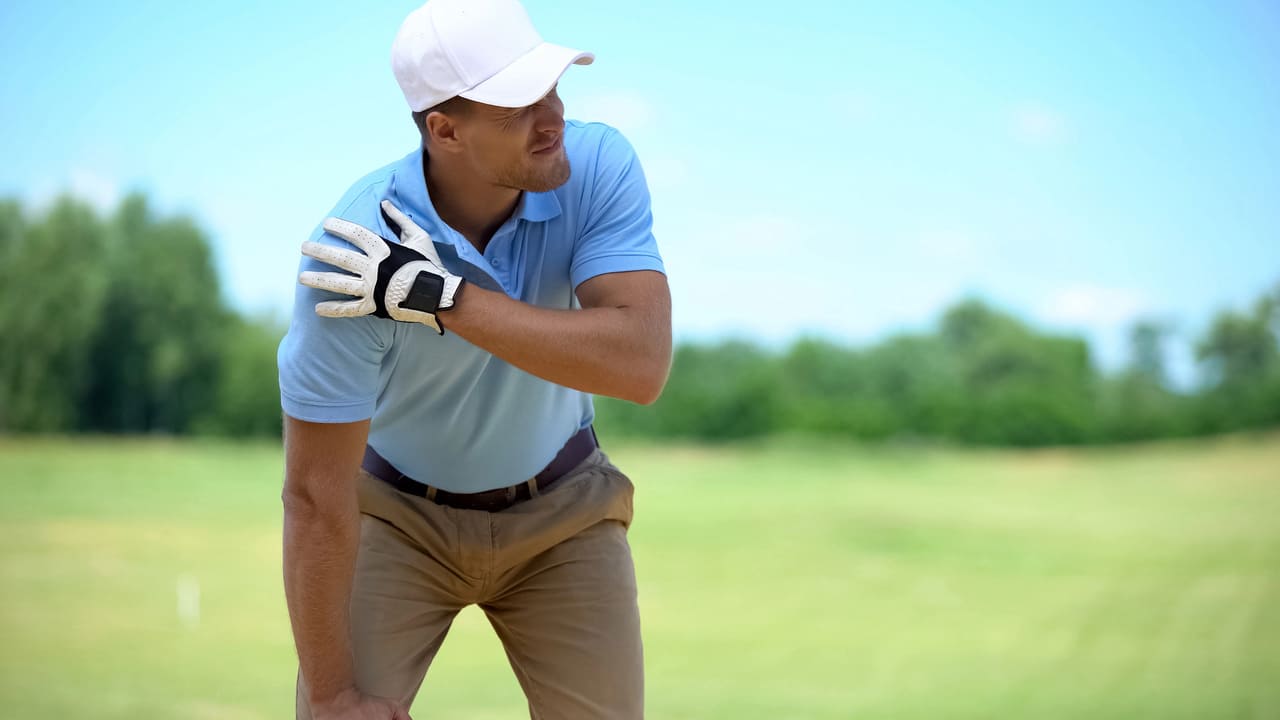Play Pain-Free and Stay on the Course: How to Prevent Golf Injuries
Golf is often seen as a low-impact sport, but that doesn’t mean it’s injury-free. From back strain to elbow tendinitis, many golfers experience pain due to repetitive motion, poor mechanics, or lack of conditioning. Whether you’re a seasoned golfer or just starting out, understanding how injuries occur—and how to prevent them—is essential to staying on the course and performing at your best. In this blog, we’ll explore the most common golf-related injuries, how to spot early warning signs, and the strategies that can help keep your game strong and pain-free.
Understanding Common Golf-Related Injuries
Despite being a low-impact sport, golf can still lead to a variety of injuries, particularly due to repetitive motions and improper technique. The most common golf-related injuries include:
- Low Back Strain: The rotational force of the golf swing places significant stress on the lower spine, especially if the core isn’t properly engaged or flexible.
- Golfer’s Elbow (Medial Epicondylitis): Caused by repetitive gripping and swinging, this condition leads to pain on the inner part of the elbow.
- Rotator Cuff Injuries: The shoulder is heavily involved in the golf swing, and overuse or poor mechanics can strain or tear the rotator cuff muscles.
- Wrist Tendinitis: Overuse or poor grip can lead to inflammation in the tendons of the wrist, especially during the follow-through phase of a swing.
- Knee Strain: Twisting motions during the swing and walking on uneven terrain can put stress on the knees, especially for golfers with pre-existing issues.
- Neck Pain: Poor posture or abrupt movements during the swing can lead to muscle strain in the neck area.
Understanding these common injuries and what causes them is the first step toward preventing them through smarter training and better technique.
Recognizing Warning Signs of a Potential Golf Injury
Recognizing the early signs of injury can help prevent a minor issue from becoming a long-term problem. Common warning signs include:
- Persistent Muscle Soreness: Soreness that doesn’t improve with rest may be a sign of strain or overuse.
- Reduced Range of Motion: Difficulty rotating your shoulders, twisting your trunk, or bending your knees may indicate an underlying joint or muscle issue.
- Tingling or Numbness: Sensations in the arms, hands, or legs can point to nerve irritation or disc problems.
- Sharp or Localized Pain: Pain during the swing, especially in the back, shoulder, or elbow, is a red flag that shouldn’t be ignored.
- Swelling or Inflammation: Puffiness around joints or tendons can signal acute injury or chronic overuse.
- Grip Weakness: A noticeable drop in grip strength may be related to wrist, elbow, or nerve-related issues.
If you notice these signs, it’s important to address them early through professional assessment and appropriate rest.
How Proper Warm-Up Reduces the Risk of Golf Injuries
Warming up before a round of golf increases blood flow to muscles, primes the joints for movement, and prepares the body for the explosive rotational force of a golf swing. A proper warm-up routine typically includes dynamic stretches, mobility exercises, and light practice swings. These activities activate the core, loosen the hips and shoulders, and enhance balance—making it easier to swing with control. Neglecting a warm-up can leave the body stiff and unprepared, increasing the likelihood of muscle strains, joint injuries, or compensatory movement patterns that lead to overuse.
Exercises That Help Prevent Golf Injuries
Certain exercises are especially beneficial for building the strength, stability, and flexibility needed for a healthy golf swing. Common injury-prevention exercises include:
- Plank Variations: Strengthen the core and protect the lower back during rotation.
- Thoracic Spine Rotations: Improve mid-back mobility, which is crucial for a fluid and safe swing.
- Glute Bridges: Strengthen the hips and reduce strain on the lower back.
- Shoulder External Rotations: Help stabilize the shoulder joint and prevent rotator cuff issues.
- Lunges With Rotation: Build leg strength and simulate golf-specific trunk rotation in a controlled manner.
- Wrist Curls and Extensions: Improve grip strength and reduce the risk of tendinitis.
Incorporating these exercises into a regular training routine can reduce injury risk while enhancing performance.
Can Poor Swing Mechanics Lead to Injury in Golf?
Absolutely. Poor swing mechanics are one of the leading causes of golf-related injuries. An inefficient or unbalanced swing can place unnecessary stress on various parts of the body, including the spine, shoulders, and knees. For example, excessive spine rotation without proper core engagement can lead to lower back strain, while an overly forceful downswing can aggravate the elbow or wrist. Repeating these flawed mechanics over time compounds the stress and increases the likelihood of chronic injuries. Working with a coach or physiotherapist to refine swing form is essential for long-term injury prevention.
Golf and Overuse Injuries: Essential Tips for Prevention
Overuse injuries develop gradually due to repetitive motions and inadequate recovery. For golfers, they often affect the elbows, shoulders, and lower back. To avoid them:
- Monitor Play Frequency: Avoid excessive rounds or driving range sessions without appropriate rest in between.
- Vary Practice Routines: Change up drills and practice swings to avoid reinforcing the same stress patterns.
- Listen to Your Body: Take breaks if you experience early signs of discomfort or fatigue.
- Cross-Train: Incorporate strength, flexibility, and aerobic training to build resilience and prevent overreliance on one movement pattern.
- Use Proper Equipment: Clubs that are too long, heavy, or stiff can force poor mechanics and increase strain.
- Stay Hydrated and Nourished: Proper hydration and nutrition support muscle function and joint health.
Awareness of overuse risks helps golfers train smarter and play pain-free for longer.
Preventing Golf Injuries: How Rest and Recovery Help
Recovery is just as important as training. Without adequate rest, the body doesn’t have time to repair tissue micro-damage caused by repetitive swings. Recovery allows muscles and joints to heal, reduces inflammation, and prevents the buildup of fatigue-related compensations that can lead to injury. Effective strategies include sleep, hydration, light activity on rest days, and using tools like foam rollers or massage therapy to enhance circulation. Taking scheduled breaks, especially during periods of high play frequency, is essential for keeping the body resilient and injury-free.
Recommended Protective Gear to Help Reduce Golf Injury Risk
While golf may not involve high-contact, certain gear can help reduce stress on joints and support better mechanics. Examples include:
- Wrist Braces or Wraps: Offer added support during swings, especially for players recovering from tendinitis or wrist sprains.
- Back Support Belts: Help stabilize the lumbar spine for golfers with a history of back pain or weakness.
- Orthotic Insoles: Provide better alignment and shock absorption during walking and weight shifts.
- Compression Sleeves: Aid in circulation and reduce muscle fatigue in the arms and legs.
- Gloves With Added Padding: Reduce grip pressure and lower the risk of elbow and wrist overuse.
- Supportive Footwear: Proper shoes enhance traction, reduce stress on the knees, and support balanced movement.
While not a substitute for training or rehab, protective gear can be a useful complement in injury prevention—especially for golfers managing pre-existing issues.
Can Physiotherapists Help With Golf Injury Prevention?
Physiotherapists play a vital role in helping golfers stay injury-free by identifying risk factors and improving physical performance. Their approach often includes:
- Movement Assessments: Therapists evaluate posture, swing mechanics, flexibility, and stability to find areas of vulnerability.
- Strengthening Programs: Customized exercises are prescribed to build strength in the core, shoulders, hips, and back—all crucial for swing stability.
- Mobility and Flexibility Work: Targeted stretching and mobility drills help reduce stiffness and improve joint health.
- Education on Swing Mechanics: Physiotherapists can provide feedback on movement patterns and recommend changes to reduce strain.
- Injury-Specific Rehabilitation: If early signs of injury are present, therapy can help manage symptoms and prevent progression.
- Warm-Up and Cool-Down Routines: These routines are tailored to the individual and help prepare the body for golf-specific movements.
With a physiotherapist’s support, golfers can build the physical foundation they need to swing efficiently and reduce their risk of injury.
Don’t Let Injury Slow You Down
If you’re serious about improving your game and avoiding injury, a proactive approach to golf injury prevention is key. From understanding your body’s limitations to refining your swing and building strength in key areas, the right knowledge can make a lasting difference. Whether you’re managing a past injury or looking to stay ahead of future issues, working with a physiotherapy professional can help you move better, feel stronger, and play longer. Contact the team at Propel Sports Physical Therapy in Edmonton South to explore personalized strategies designed to support your performance and protect your body.


